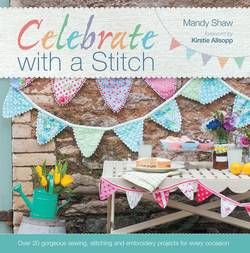Читать книгу Celebrate with a Stitch - Mandy Shaw - Страница 7
ОглавлениеFabrics and Threads
The fabrics I have used for the projects in this book have a retro Fifties feel with lots of spots, checks and stripes. I used a colour palette of pastels and primary colours which, I hope you will agree, gives a fresh, bright look that will appeal to all ages.
Fabrics
If you are new to making things from fabric you are in for a great treat. You have so much to look forward to as you build your fabric collections, from sourcing fabric shops, to stashing your buys on little shelves or in a special drawer. I love to work with 100% cotton to give a clean, crisp textured look to my makes. It is advisable to wash and press your fabrics before you sew in case the colour runs. Fabrics are often treated with a sort of starch dressing to make them easier to sew; after washing and drying, you may find that giving your fabrics a little spray starch will aid sewing.
Felt
I adore working with felt as it does not fray; it is lovely to sew, and especially to blanket stitch. There are various qualities of felt, which perform differently with wear; always buy felt that has a percentage of wool in it – the higher the better – as this will help to prevent the felt’s surface from going bobbly over time.
Vintage
Vintage fabrics are a favourite of mine – embroidered cloths, lace hankies, cotton monogrammed linens and similar treasures can be sourced from internet auctions, car boot sales and secondhand shops; you never know what you will discover.
Tip
Use a fabric spray adhesive to attach wadding (batting) to your fabric. Follow the manufacturer’s instructions and spray the wadding (batting) not the fabric.
Embroidery threads
As the projects call for different styles of stitching, I have used different types of embroidery thread. Stranded cotton (floss) is good for fine work but can be used to embroider thicker lines too, while coton à broder is sometimes too thick for the detailed work required on some projects, so mix and match as you choose.
Coton à broder
A favourite of mine, this single strand thread has a matt finish. It is available in different widths in several colours. I prefer No.16 which is quite thick and ideal for blanket stitching, outlining, backstitching, and quilting. Although shops rarely stock the whole range, they can be ordered.
Stranded cotton (floss)
This is available in skeins consisting of six strands which can be pulled out individually for use. It is most usual to use two strands in the needle, but for fine detail use just one, and for a chunkier stitching line use three or more.
Maderia Lana
This is a machine sewing thread that looks like wool and sews up a treat to give a hand blanket stitch appearance. You will need to use a larger size 16/100 needle; make sure you use a good-quality one as cheaper needles may have burrs that will shred the thread. For the bobbin thread, use an ordinary thread. Maderia Lana can also be used to hand quilt and embroider, and you will need to use a large-eyed, good-quality needle.
Sewing notions
When making up your projects, always use a good-quality sewing thread in a colour to match your chosen fabrics.
Invest in a pack of good-quality mixed embroidery needles. These have large eyes and are very sharp, piercing the fabric and allowing the thread to be pulled through with very little friction. How do you know what size needle to use? If after three attempts the needle won’t thread, change to one with a larger hole. My personal favourites are sashiko needles size 12.
